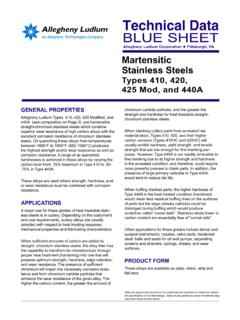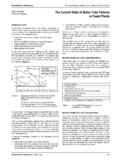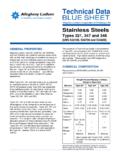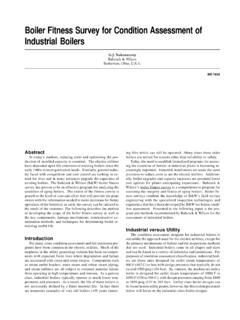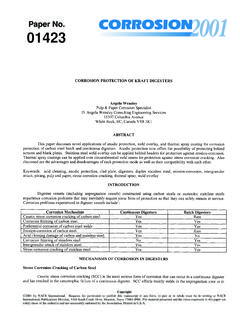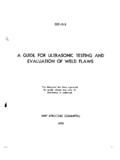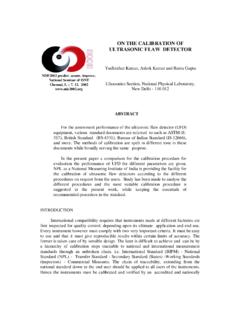Transcription of Standard Recommendations for Pressure Part …
1 Babcock & NakonecznyBabcock & WilcoxBarberton, Ohio, to:ICOLM (International Conference on Life Managementand Life Extension of Power Plant)May 2000Xi an, ChinaStandard Recommendations for Pressure PartInspection During a Boiler Life Extension ProgramBR-1701 AbstractDue to the high costs of new boiler fabrication and erection,increasing efforts are being made to extend the life of existingunits. The life extension and reliability of these plants is under-mined if unscheduled and forced outages occur. Determinationof the Pressure parts requiring inspection, type of inspectionsto be performed, and the amount and location of these inspec-tions has always been a major concern in boiler life complexity of the problem increases when the boiler s age,operating history, and failure history are taken into account.
2 Overthe years, The Babcock & Wilcox Company has inspected andprovided life extension Recommendations on boilers of everystyle from every manufacturer around the world. These recom-mendations are based on B&W s accumulated experience. Thispaper presents Babcock & Wilcox s approach for the recom-mendations for boiler Pressure part life extension inspection re-quirements to ensure the safe and reliable operation of goals of today s condition assessment and life exten-sion programs are to increase the availability, efficiency, andreliability of the existing power plants and ensure safe and costeffective operation. In planning a condition assessment program,it is important to look at both the operating history and objec-tives for the boiler.
3 Presented in the following paper is the pro-gram and methods recommended for the assessment of the boilerpressure parts. The Recommendations consider the typical areasof concern. However, they are not intended to address everyboiler or be all inclusive of every problem that may be encoun-tered. All inspection plans are unique to the specific unit andshould be made based on that unit s history and operating char-acteristics. The more information known about a specific unit,the more a detailed and cost effective inspection plan can PlanThe inspection scope depends on several factors such as theboiler design type, design temperatures and pressures, materi-als, fuels, age, unit history, as well as future plans and operat-ing conditions. B&W follows a multi-level approach in the plan-ning of the survey Level 1 of a Condition Assessment inspection plan, anevaluation of the plant s operating history and review of his-torical problem areas is performed.
4 Based on this review, a de-tailed inspection plan is developed and implemented in Level2. Nondestructive examination is then used to evaluate the cur-rent condition and estimate the remaining life of the inspectedcomponents. After the conclusion of the inspection program,the results are used in the planning of re-inspection and regularpreventive maintenance to ensure reliable operation. The inspec-tion is centered around the critical components. Generally, thecritical components are those whose failure will directly affectthe reliability of the boiler. The critical components can be pri-oritized by the impact they have on safety, reliability, and per-formance. These critical Pressure parts include:lDrums steam, lowerlHeaders both steam and waterlTubing superheater, generating, waterwall, economizerlPiping steam and feedwaterlDeaerator may have special safety concernslAttemperators2 Babcock & WilcoxThe inspection work scope is based on the individual unit soperating history, failure history, and expected failure mecha-nisms for each critical Pressure are typical inspection plans for critical pressureparts.
5 These inspection plans are expected to be altered basedon any additional unit information. Initially a comprehensiveinspection of each Pressure component should be made to givebaseline data for future reference. Although expensive and timeconsuming, the advantage to this method is that it determines atime frame when any damage has DrumsSteam drum The steam drum is the most expensive boilercomponent and must be included in any comprehensive condi-tion assessment program. There are two types of steam drums,the all welded design used predominantly in electric utilitieswhere the operating pressures exceed 1800 psi (124 bar), anddrums with rolled tubes. Because of its relatively low operatingtemperature, the drum is made of carbon steel and is rarely sub-ject to significant creep damage.
6 Creep is defined as increasingstrain at a constant stress over is primarily due to internal metal loss. The causesof metal loss include corrosion and oxidation, which can occurduring extended outages, acid attack, oxygen pitting, and chelantattack. Damage can also occur from mechanical and thermalstresses on the drum which concentrate at nozzle and attach-ment welds. These stresses, most often associated with boilersthat are on/off cycled, can result in crack development. Cyclicoperation can lead to drum distortion (humping) and can resultin concentrated stresses at the major support welds, seam welds,and girth welds. The feedwater penetration area has the great-est thermal differential because incoming feedwater can be sev-eral hundred degrees below drum temperature.
7 Based on this,these areas should be inspected during any boiler life problem unique to steam drums with rolled tube seats istube seat weepage (slight seeping of water through the rolledjoint). If the leak is not stopped, the joint, with its high residualstresses from the tube rolling operation, can experience causticembrittlement. In addition, the act of eliminating the tube seatleak by repeated tube rolling can overstress the drum shell be-tween tube seats and lead to ligament drum The lower or mud drum is found mostly in in-dustrial boilers. part of the boiler s water circuit, the lower drumis not subject to large thermal differentials or mechanicalstresses. However, as in steam drums with rolled tubes, seatweepage and excessive stresses from tube rolling can occur.
8 Inmost cases visual inspection, including fiber optic probe ex-amination of selected tube penetrations, is sufficient. Manylower drums are subject to corrosion of the tube-drum interfaceon the outside diameter (OD). This area of the drum is inacces-sible, therefore inspections are conducted from the inside di-ameter (ID) using Standard ultrasonic Thickness Testing (UTT)and electromagnetic acoustic transducers (EMATs) to check forcracking and wall Typical inspections of the drums during a baselinecondition assessment program consist of a thorough visual in-spection along with a Wet Fluorescent Magnetic Particle(WFMT) inspection of all welded nozzles and attachments. Thedrum shell ID longitudinal and circumferential welds should beWFMT and UTT inspected.
9 Selected bore hole ligaments shouldbe WFMT Life Assessment In the absence of any significant dam-age the drum will normally not be life-limited as it is not sub-ject to significant TubingBoiler tube failures are the primary cause of forced texts are available to address all the problems anddamage mechanisms that can lead to failures(1) and we have notattempted to identify or discuss every damage mechanism inthis Steam-cooled tubing is found in the super-heater (high Pressure ) and reheat superheater. Both componentshave tubes subjected to the effects of metal creep. Because mostboilers targeted for condition assessment are at least 20 yearsold, superheaters have become critical assessment is a function of temperature, stress and operating creep life of the superheater tubes is reduced by a higheroperating temperature and by other damage mechanisms, suchas erosion and corrosion, causing tube wall thinning and in-creased stresses.
10 Excessive stresses associated with thermalexpansion and mechanical loading can also occur, leading totube cracks and leaks independent of the predicted creep a period of time, superheater tubing exposed to elevatedtemperatures experiences an ID oxide growth (Fig. 1). This in-ternal oxide interferes with the cooling effect of the steam flow,causing tube metal temperatures to increase. The resultant in-crease in temperature will drastically reduce the life of the internal oxide may also exfoliate, causing erosion of valvesand turbine components. For certain fuels, the life of the super-heater tubing can be greatly reduced by high rates of erosionand corrosion which drives tube degradation more than tem-perature and oxide growth.
